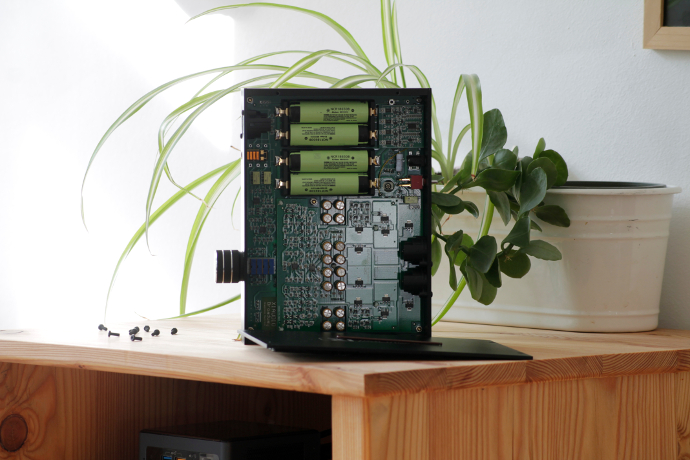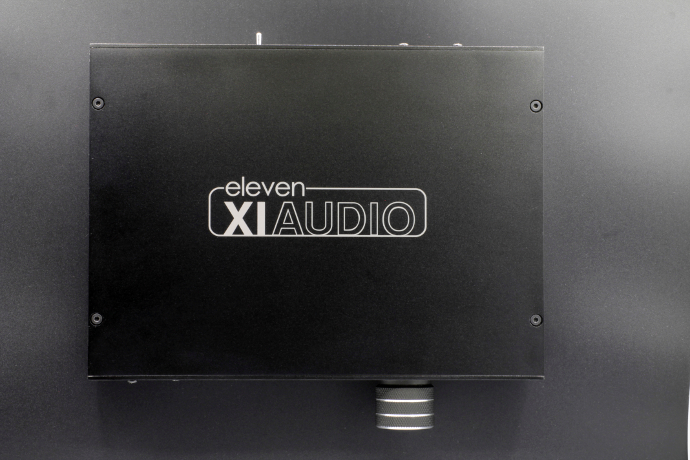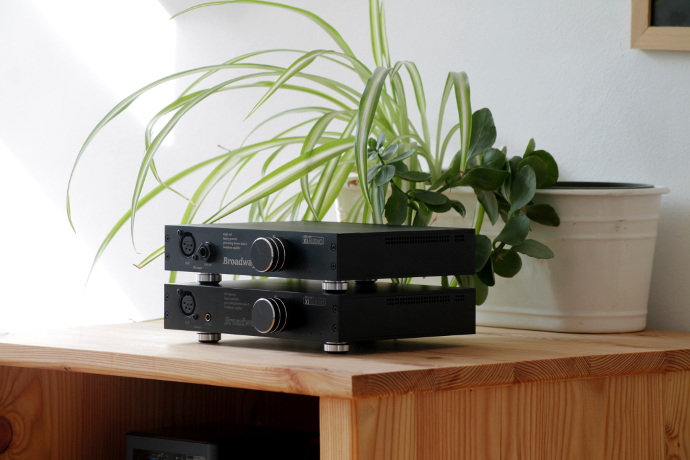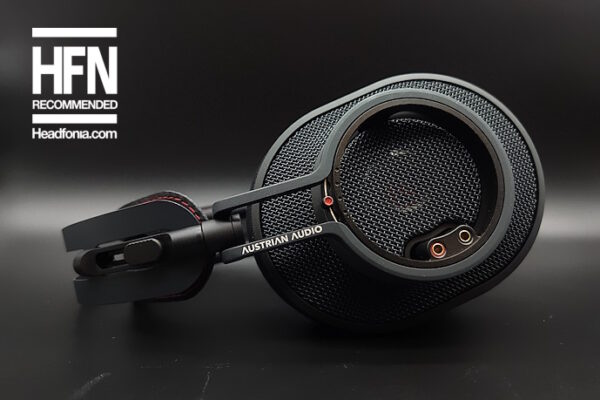Control:
[responsivevoice_button]
Using the Broadway amplifiers is rather straight forward, given it doesn’t do much other than amplifying. One thing has to be noted. You can’t use the amplifier without batteries. They have to be installed no matter what.
First connect all inputs to the amplifier and then hook it up to your power outlet. One thing that really bothers me is the on/off switch. It’s a flick switch and does not flip as easily as I hoped. On top of that, it’s also on the back, which to me is not where a power button/switch should be for ease of use. After confronting XI Audio about that, they told me that the power switch is hard to use on purpose. It is to avoid miss-operation if the amplifier is carried around in a bag or backpack.
Once you have turned on your amp and you’re sending a signal to it via your DAC, you can connect your headphones to the outputs on front. Adjust the volume pot until you reach your desired loudness.
If you want to use a different gain settings, you have to turn the amp upside down. The dip-switches are located at the bottom of the amp, which again is is not ideal for user experience.
Should you have to replace the batteries, just unscrew the four screws from the top and front plate, so you can take the top off. Then you have access to the batteries and can replace them with new ones. I bought a set of four 18650 Li-Ion rechargeable batteries for 35€.
Package:
My units didn’t arrive in retail packaging. What I got was a plain brown box with both amplifiers separately packed inside, along with two power supplies and a screw driver.
I assume customers will get the same content but in a nicer package.

XI Audio Broadway & Broadway S
Build Quality:
The build quality of the Broadway amplifiers overall is good, but there are things that really bother me. Let’s start with the good first.
Both amplifiers are made out of aluminum. They are very small for desktop amps, which makes both of them transportable, should you ever want to take your amps with you, you can. They measure 212 x 195 x 48mm (WxDxH) and put approximately 1,100 Grams on the scale.
Corners on the units are sharp, so should you accidentally hit them with something, you’re very likely to leave a dent or scratch. They both come in black color with white print on the front, back and top. While the volume potentiometer might not be aesthetically pleasing, it is implemented exemplary well. This is one of the very first things I check with any new amp. The Broadway’s volume pots turn smoothly and steadily. They don’t wobble or squiggle.
The feet of the amplifiers look very solid, but it’s the three-legged design that probably annoys me the most about the Broadway amps. Whenever I turn the amps on or off, remember the switch is on the back, the amplifiers tilt upwards. Unless I hold the amplifiers down with my hands, or I have some weight to support that, they will always tilt. After I told XI Audio about my issues with the feet, they assured me that the new batch of Broadway and Broadway S amplifiers will come with a four-legged design.
Also the fact that the power and gain switches are not on the front annoys me a lot. These are essential to the user experience and should be accessible without any hassle.
Although XI Audio uses Neutrik connectors, I think the 6.35mm output on the Broadway S doesn’t reflect its price. Of course, that’s nit-picking, but I would wish for something more visually adequate to the premium price of the Broadway S.
Since both amplifiers are Class A designs, they run hot. The heat-dissipation works through their cases, but there are no dedicated heat-sinks. Which makes the case get hotter than other amplifiers. So make sure that you put the Broadway amps somewhere, where there is enough air-flow.

XI Audio Broadway & Broadway S
Sound:
Now we’re getting to the good stuff. The most important aspect of an amplifier is its sound. I have connected the Broadway amplifiers to the Matrix Audio Element M’s dual outputs. The RCA output is rated at 2V RMS while the XLR output doubles it to 4V RMS, which in both cases is standard practice. We’ll go over each amplifier in its own section. I used the HiFiMAN Susvara and HE1000se, as well as the Abyss Diana Phi and Diana V2 and the MrSpeakers Ether 2 headphones for sound evaluation. I also reached for different universal and custom IEMs for the Broadway S.
Broadway
The Broadway has a generally neutral and natural sound. It has excellent grip, weight and authority in the bass, clear mids and clean highs. One of its biggest strengths is the level of details. It presents micro details clean with very nice precision.
Bass has good body and weight on the Broadway. It presents lows with excellent dynamics and punch. It’s not an overly full and thick low-end of other Class A amplifiers, but it delivers superb resolution and texture. The Broadway gives lows very good definition and drive. Bass is tight and fast paced. With the Broadway I get very good texture in lower pitched string instruments, where the vibrations of the separate strings can come out nicely physical and organic.
In the mids the Broadway sounds transparent but rich. There isn’t a lot of coloring going on in the Broaway to my ears. Lower mid-range has excellent body, weight and density. The center mid-range sounds slightly thinner but with good levels of richness and sweetness.
Instruments sound natural and clear. They have superb definition and resolution. Mids in general have a full bodied sound and a wonderful softness to them. Vocals sound emotional and harmonic. The space and air in the mid-range is just about right. Singers have enough room to breathe, where they don’t sound congested or closed in. There is good openness in the mids as well.
In terms of technical performance I think the Broadway is a good performer. It presents a vast amount of details with very good resolution. It holds a strict structure and keeps its solidity. The sound stage is stretching in good dimensions, but doesn’t reach the width or depth of other amplifiers. Still, it creates a wide stage with very good layering and imaging. It places instruments on a very dark background and highlights every information with wonderful contours.
Treble is fast, snappy and clean. At times hi-hat hits and cymbal crashes can sound a bit harsh and edgy. Highs have good energy and sparkle. It’s a neutral treble, without any extra brightness. The Broadway’s treble is not as rich and soft as its mid-range for example, which can take highs to a degree where they can sound hard to the ear.
Broadway S
It really isn’t surprising that the Broadway and Broadway S have a lot in common. Their general tuning is pretty much the same. Natural and neutral with good dynamics and details. A slightly rich mid-range and a hard edged top-end. Their main difference lies in driving power and grip to me. Let’s dig deeper.
The Broadway S also has a weightier and fuller low-end presentation, where it delivers good punch and speed. Bass is fast and energetic with good resolution and texture. It doesn’t possess the same strict grip as the bigger Broadway, but it still maintains a very solid pull.
There is good weight and density in the lower mid-range, especially deep male vocals sound very physical and almost vibrant. Overall mids have very nice texture and richness. Instruments sound organic and realistic with a natural body. They are not oversized or too thick. That’s just how I like them really. Mids are almost uncolored, if it weren’t for the slightly stronger lower mids. Male and female singers have very nice emotions in them and come out with good air around them.
On a technical perspective, the Broadway S is again a lot like the Broadway. You get good staging and imaging. It renders a very fine picture with high resolution and very nice separation. At times I feel the instruments could be separated with a sharper cut though.
Treble does have a hard edge and high energy. It’s a neutral but clean treble, that doesn’t hide behind any other frequency range, resulting in a clear response. Just like on the Broadway, I wish for some extra richness in the treble to make it sound a bit softer.
More about the Broadway amplifiers on the next page.








cfranchi
Hello Linus,
Given your review of FA-10, I have ordered it, given the price and the quality of it, I think I won’t regret my buy (it is to power Hifiman HE6-se).
You said that Broadway S drives headphone with more authority and punch than FA-10 (that’s funny given the huge power difference) : is it true even for hard to drive headphone like Susvara ?
Thank you
Linus
Hi Cfranchi,
thanks for your comment.
I am very sure you won’t regret buying the FA-10. It’s a fantastic amplifier.
As for your question. The Broadway S won’t power the Susvara to its fullest. The comparison was more in regards to easier to drive headphones.
You’re safe with the FA-10. No worries. 🙂
Hope that helps.
cfranchi
Thx, of course I was wrong, I didn’t talk about Broadway S but about its big brother the Broadway.
Guy Lamaar
Battery powered, transportable desktop amp? How about a Bakoon HPA-01? Sits between the 2 Broadways in terms of power & price, but top of the tree in terms of build quality. How do they compare in terms of sound?
cfranchi
Really don’t understand this notion of output current and output voltage. Amp power P = U*U / R = I*I * R : R is the headphone impedance and so U and I have fixes values for a given R.
John
It would have been interesting to read how Broadway S copes with more sensitive full size headphones. Like something from Fostex, or Ananda, or maybe even Focal Stella?
Linus
Hi John,
thanks for your comment.
I agree, but sadly I don’t have these headphones in my inventory. My collection of headphones concentrates on harder to drive right headphones. If I ever get the chance to audition easier to drive headphones with the Broadway S I will let you know how they play together.
Again, thanks for your feedback. 🙂
Cheers
Linus
Hi Guy Lamaar,
you’re right about the Bakoon. Didn’t think about that one. Also haven’t had the chance to listen to it ever. I’m not sure if I even saw it in person, so I can’t compare them. Sorry.
Cheers